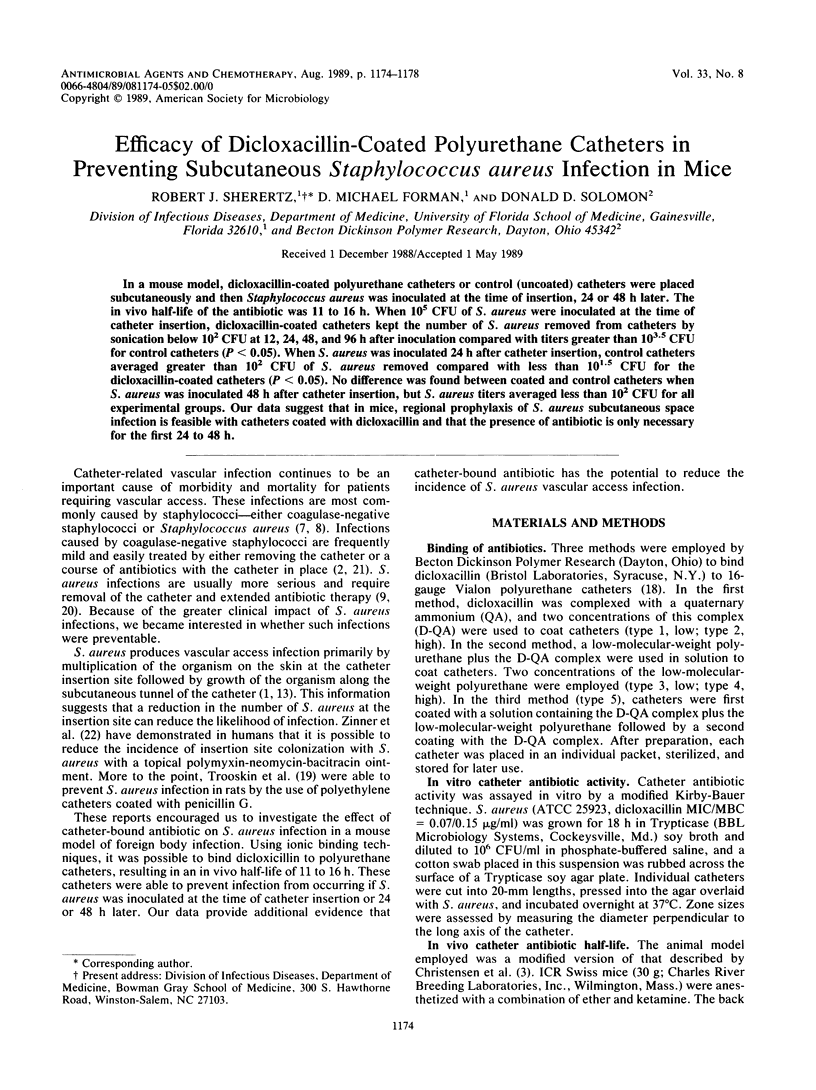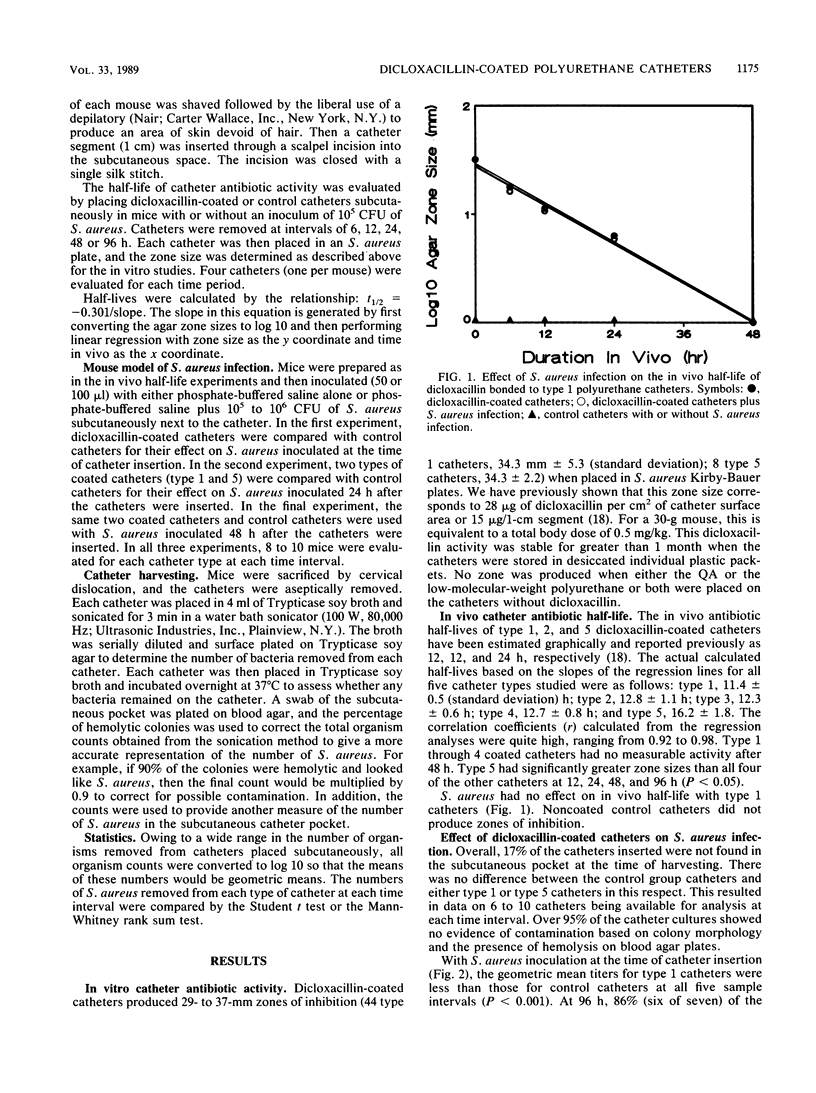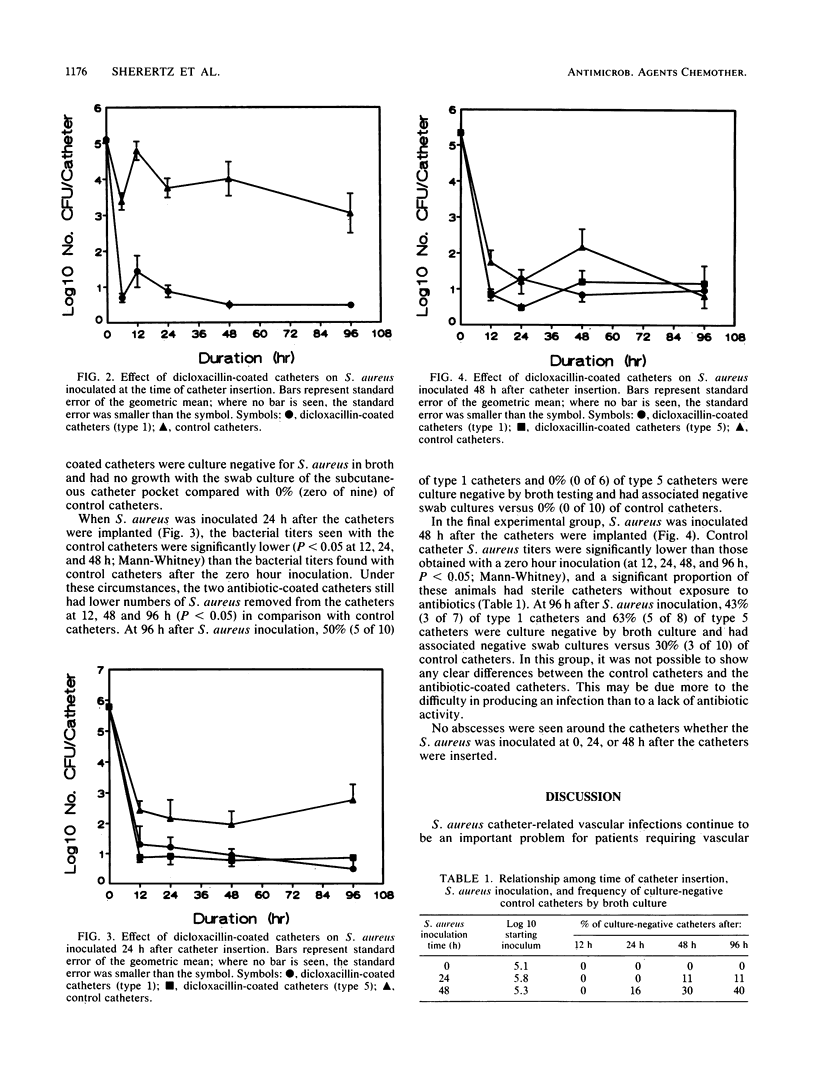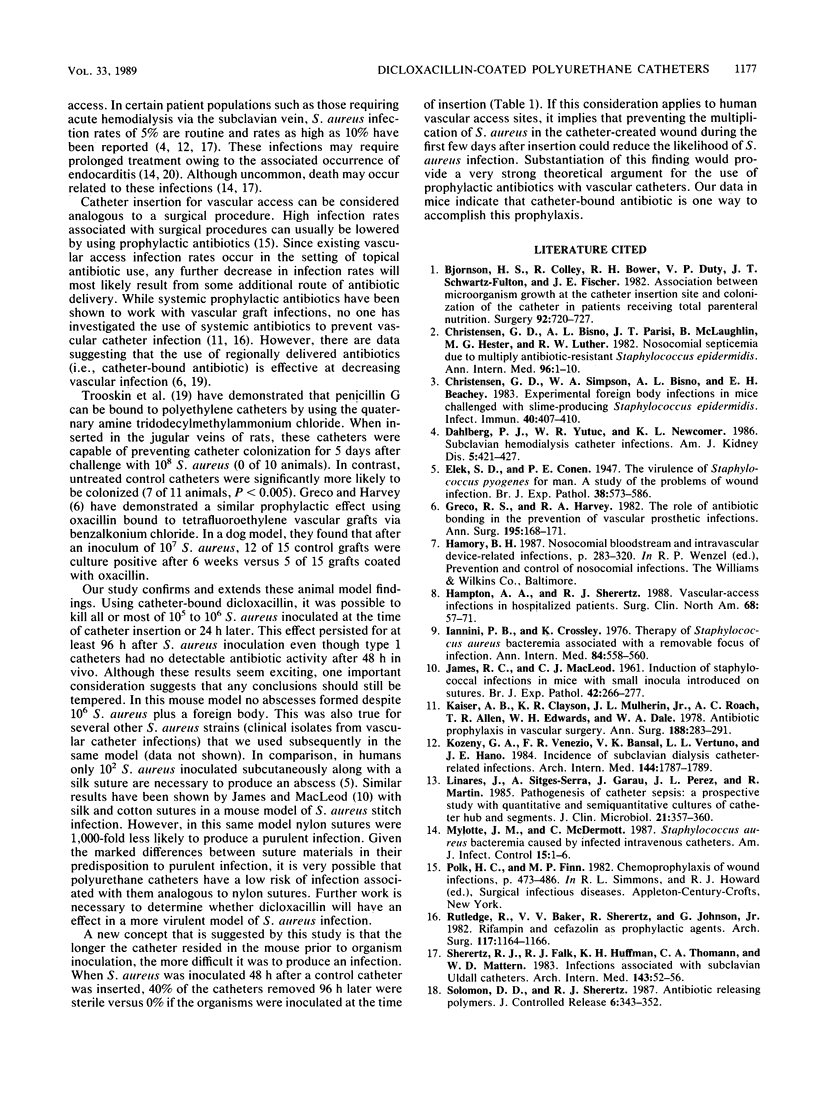Abstract
In a mouse model, dicloxacillin-coated polyurethane catheters or control (uncoated) catheters were placed subcutaneously and then Staphylococcus aureus was inoculated at the time of insertion, 24 or 48 h later. The in vivo half-life of the antibiotic was 11 to 16 h. When 10(5) CFU of S. aureus were inoculated at the time of catheter insertion, dicloxacillin-coated catheters kept the number of S. aureus removed from catheters by sonication below 10(2) CFU at 12, 24, 48, and 96 h after inoculation compared with titers greater than 10(3.5) CFU for control catheters (P less than 0.05). When S. aureus was inoculated 24 h after catheter insertion, control catheters averaged greater than 10(2) CFU of S. aureus removed compared with less than 10(1.5) CFU for the dicloxacillin-coated catheters (P less than 0.05). No difference was found between coated and control catheters when S. aureus was inoculated 48 h after catheter insertion, but S. aureus titers averaged less than 10(2) CFU for all experimental groups. Our data suggest that in mice, regional prophylaxis of S. aureus subcutaneous space infection is feasible with catheters coated with dicloxacillin and that the presence of antibiotic is only necessary for the first 24 to 48 h.
Full text
PDF




Selected References
These references are in PubMed. This may not be the complete list of references from this article.
- Bjornson H. S., Colley R., Bower R. H., Duty V. P., Schwartz-Fulton J. T., Fischer J. E. Association between microorganism growth at the catheter insertion site and colonization of the catheter in patients receiving total parenteral nutrition. Surgery. 1982 Oct;92(4):720–727. [PubMed] [Google Scholar]
- Christensen G. D., Bisno A. L., Parisi J. T., McLaughlin B., Hester M. G., Luther R. W. Nosocomial septicemia due to multiply antibiotic-resistant Staphylococcus epidermidis. Ann Intern Med. 1982 Jan;96(1):1–10. doi: 10.7326/0003-4819-96-1-1. [DOI] [PubMed] [Google Scholar]
- Christensen G. D., Simpson W. A., Bisno A. L., Beachey E. H. Experimental foreign body infections in mice challenged with slime-producing Staphylococcus epidermidis. Infect Immun. 1983 Apr;40(1):407–410. doi: 10.1128/iai.40.1.407-410.1983. [DOI] [PMC free article] [PubMed] [Google Scholar]
- Dahlberg P. J., Yutuc W. R., Newcomer K. L. Subclavian hemodialysis catheter infections. Am J Kidney Dis. 1986 May;7(5):421–427. doi: 10.1016/s0272-6386(86)80092-0. [DOI] [PubMed] [Google Scholar]
- ELEK S. D., CONEN P. E. The virulence of Staphylococcus pyogenes for man; a study of the problems of wound infection. Br J Exp Pathol. 1957 Dec;38(6):573–586. [PMC free article] [PubMed] [Google Scholar]
- Greco R. S., Harvey R. A. The role of antibiotic bonding in the prevention of vascular prosthetic infections. Ann Surg. 1982 Feb;195(2):168–171. doi: 10.1097/00000658-198202000-00008. [DOI] [PMC free article] [PubMed] [Google Scholar]
- Hampton A. A., Sherertz R. J. Vascular-access infections in hospitalized patients. Surg Clin North Am. 1988 Feb;68(1):57–71. doi: 10.1016/s0039-6109(16)44432-4. [DOI] [PubMed] [Google Scholar]
- Iannini P. B., Crossley K. Therapy of Staphylococcus aureus bacteremia associated with a removable focus of infection. Ann Intern Med. 1976 May;84(5):558–560. doi: 10.7326/0003-4819-84-5-558. [DOI] [PubMed] [Google Scholar]
- JAMES R. C., MACLEOD C. J. Induction of staphylococcal infections in mice with small inocula introduced on sutures. Br J Exp Pathol. 1961 Jun;42:266–277. [PMC free article] [PubMed] [Google Scholar]
- Kaiser A. B., Clayson K. R., Mulherin J. L., Jr, Roach A. C., Allen T. R., Edwards W. H., Dale W. A. Antibiotic prophylaxis in vascular surgery. Ann Surg. 1978 Sep;188(3):283–289. doi: 10.1097/00000658-197809000-00003. [DOI] [PMC free article] [PubMed] [Google Scholar]
- Kozeny G. A., Venezio F. R., Bansal V. K., Vertuno L. L., Hano J. E. Incidence of subclavian dialysis catheter-related infections. Arch Intern Med. 1984 Sep;144(9):1787–1789. [PubMed] [Google Scholar]
- Liñares J., Sitges-Serra A., Garau J., Pérez J. L., Martín R. Pathogenesis of catheter sepsis: a prospective study with quantitative and semiquantitative cultures of catheter hub and segments. J Clin Microbiol. 1985 Mar;21(3):357–360. doi: 10.1128/jcm.21.3.357-360.1985. [DOI] [PMC free article] [PubMed] [Google Scholar]
- Mylotte J. M., McDermott C. Staphylococcus aureus bacteremia caused by infected intravenous catheters. Am J Infect Control. 1987 Feb;15(1):1–6. doi: 10.1016/0196-6553(87)90069-1. [DOI] [PubMed] [Google Scholar]
- Rutledge R., Baker V. V., Sherertz R., Johnson G., Jr Rifampin and cefazolin as prophylactic agents. A comparison in an animal model of vascular graft infection. Arch Surg. 1982 Sep;117(9):1164–1165. doi: 10.1001/archsurg.1982.01380330028008. [DOI] [PubMed] [Google Scholar]
- Sherertz R. J., Falk R. J., Huffman K. A., Thomann C. A., Mattern W. D. Infections associated with subclavian Uldall catheters. Arch Intern Med. 1983 Jan;143(1):52–56. [PubMed] [Google Scholar]
- Trooskin S. Z., Donetz A. P., Harvey R. A., Greco R. S. Prevention of catheter sepsis by antibiotic bonding. Surgery. 1985 May;97(5):547–551. [PubMed] [Google Scholar]
- Watanakunakorn C., Baird I. M. Staphylococcus aureus bacteremia and endocarditis associated with a removable infected intravenous device. Am J Med. 1977 Aug;63(2):253–256. doi: 10.1016/0002-9343(77)90239-x. [DOI] [PubMed] [Google Scholar]
- Winston D. J., Dudnick D. V., Chapin M., Ho W. G., Gale R. P., Martin W. J. Coagulase-negative staphylococcal bacteremia in patients receiving immunosuppressive therapy. Arch Intern Med. 1983 Jan;143(1):32–36. [PubMed] [Google Scholar]
- Zinner S. H., Denny-Brown B. C., Braun P., Burke J. P., Toala P., Kass E. H. Risk of infection with intravenous indwelling catheters: effect of application of antibiotic ointment. J Infect Dis. 1969 Nov;120(5):616–619. doi: 10.1093/infdis/120.5.616. [DOI] [PubMed] [Google Scholar]


